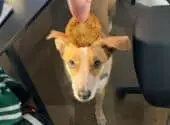Who doesn’t love cotton candy? The sugary treat is a staple of carnivals and fairs, and it’s hard not to be tempted by its colorful appearance. But what about our furry friends? Can dogs eat cotton candy, too?
As pet owners, we always want to ensure our dogs’ dietary requirements are being met. We want to know what’s safe for them to consume and what is toxic.
So, if you’re unsure whether cotton candy is a safe snack for your pup, keep reading to find out.

What is Cotton Candy?
Sugar is heated to create a liquid which can then be spun through tiny holes, cooling and solidifying into strands. This intricate process creates an edible product that appears as a mass of tangled fibers, mimicking the look of cotton when collected on a stick or cone. Usually sold in amusement parks, fairs, and carnivals, the sugary wisps are called ‘cotton candy’ for their unique form and texture.
The process of making cotton candy requires a machine specifically designed for the purpose: the cotton candy maker, which has a spinning head, an associated heater, and a receptacle to contain sugar. Heating up enables the sugar crystals to liquefy at high heat levels. Centrifugal force stemming from the spinner drives the now-liquid state towards small openings where it cools and condenses into thin threads. These strands are then gathered into fluffy mounds, building layer upon layer as the machine spins.
Cotton candy presents an eye-catching visual, with hues typically pink, blue, or yellow. It is exceptionally light and has a dissolving texture that melts in the mouth. Its sweetness, blended with the sensation of melting, provides a one-of-a-kind sensation that can prove difficult for many to resist indulging in. It also has a transient nature due to moisture or humidity, causing it to rapidly decrease in size soon after being created.
Cotton candy generally consists of sugar as its main ingredient; however, various flavors and colors can be added to modify the taste and look. More typical flavorings include vanilla, strawberry, raspberry, and blueberry. More unique infusions such as bubblegum, watermelon, or bacon have been incorporated into cotton candy in recent years. This allows people to find a cotton candy suitable for their palate from a generous selection available today.
Can Dogs Eat Cotton Candy?
Considering that dogs have nutritional and digestive requirements which are different from humans, it is important to ask: Is cotton candy safe for dogs? Though cotton candy may seem harmless enough to present as a treat for our furry friends, it is generally not recommended due to multiple factors.
To start, it should be noted that cotton candy mainly comprises sugar, a substance not part of a dog’s exceptionally particular diet. Dogs have distinct metabolisms, and their capacity to handle sugar successfully is restricted. Overeating sugar has been found to cause weight gain, oral sicknesses, and diabetes in dogs. In addition, treats containing large amounts of sugary substances can prompt an excessive increase in blood glucose levels, leading to agitated behavior and potentially lasting effects on their well-being over time.
Additionally, the texture of cotton candy is hazardous to dogs. Cotton candy will quickly melt away when coming into contact with saliva. It can clump together, consequently creating a choking hazard or blocking possible ingestion within the digestive tract if consumed in large amounts. This risk increases significantly for smaller dogs or those who do not chew their food before swallowing it.
An additional issue to consider is the utilization of synthetic preservatives and colors commonly added to cotton candy. These additives are not consumable for pups and may lead to digestive complications, hypersensitive reactions, or other disadvantageous influences in dogs. Substances such as food colors might not be well-received by dogs and could result in intestinal issues, including vomiting and diarrhea.
Ultimately, cotton candy contains no nutrients necessary for a healthy dog diet. It does not provide essential vitamins and minerals, nor can it assist with strengthening their immune system; regular consumption may lead to nutritional deficiencies that make them susceptible to developing diseases or infections.
Does Cotton Candy Contain Xylitol?
Cotton candy is composed of granular sugar, food dyes, and seasonings. Xylitol is occasionally used as an alternative to the conventional sugar and may be found in chewing gum, confectionery items, and prepared goods as a lower-calorie option.
Generally, the standard ingredients for cotton candies don’t include xylitol. The main element of cotton candy is sugar, which offers a sweet taste and distinct texture. Xylitol is rarely incorporated into the production process of cotton candy, as it contains different qualities than sugar.
Given the prevalence of obesity and other health-related issues, some manufacturers may choose to utilize alternative sweeteners or sugar substitutes to create healthier or lower-calorie types of cotton candy. This could potentially include xylitol or a similar substitute. Therefore, consumers must examine each product’s ingredient list before purchasing to discern if xylitol has been utilized.
Xylitol poses a grave danger to dogs as it has extremely damaging metabolic consequences. When xylitol is consumed, the body absorbs it rapidly, which triggers an abrupt burst of insulin from the pancreas, causing a dangerous decline in blood sugar levels or hypoglycemia. Thus, for safety reasons, dogs should strictly avoid xylitol ingestion.
Hypoglycemia is a serious and potentially life-threatening condition with symptoms like fatigue, vomiting, seizures, and comas. It can develop rapidly – within a quarter-hour to half an hour of ingestion – calling for urgent intervention. The toxicity depends upon the amount consumed relative to the dog’s body size; this means that a single piece of candy may be enough to become toxic for a smaller dog.
Furthermore, the ingestion of xylitol can be poisoning to dogs and can ultimately cause acute liver necrosis, which is life-threatening. The exact mechanism behind xylitol-induced liver damage is not definitively known yet. Still, it is believed that a rapid insulin release leads to a sequence of events destroying liver cells.
How Much Cotton Candy Can A Dog Eat?
Ingesting even a small amount of cotton candy can potentially harm dogs, as it does not contain the vital nutrients they need to stay healthy, and its high sugar content can cause various health issues. Therefore, owners are strongly advised not to offer their dogs cotton candy.
Instead, concentrate on offering your dog a diet rich in essential nutrients. Various treats have been designed with dog nutrition in mind and can be safely consumed by your pet.
Safe Alternatives To Cotton Candy Treats
Thankfully, there are a number of tasty treats that can be enjoyed by your dog that pose no risk.
Fresh Fruits
Dogs can benefit from consuming certain types of fresh fruit as these provide vital vitamins, minerals, and antioxidants for their well-being. It must be considered that the good fruits should be chosen, and they need to be given in carefully monitored amounts.
Dogs can digest fruits well, such as apples; which are high in dietary fiber and vitamin C. They provide multiple health benefits, like regularizing bowel movements and improving immunity. Nevertheless, humans must be careful when giving their dogs apples as ingesting seeds and core can lead to suffocation or even poisoning due to cyanic compounds inside them.
Dogs can consume bananas as a source of nourishment. This fruit contains essential minerals like potassium and multiple vitamins and can benefit the heart and muscle functioning. Additionally, their softer texture allows for proper digestion within a canine’s body.
Blueberries are also suitable for dogs, with their high quantities of antioxidants, minerals, and vitamins. They possess remarkable health benefits that can improve cognitive functioning and reinforce the body’s immune system.
Strawberries are a desirable snack for dogs, as they boast several vital nutrients, including vitamin C and dietary fiber, which contribute to their digestion and immune system. Caution must be taken before offering them the fruit – rinse off any dirt thoroughly and remove the stems.
When introducing new fruits to dogs, it is essential to proceed with caution. To determine if any sensitivities or allergies exist, gradual introduction and close monitoring of the dog’s reaction should occur. Additionally, as a precautionary measure and preventative health step, portions of fruit should be kept moderate to avoid possible gastrointestinal issues and weight gain.
Note: Dogs should not be fed food items that are not good for their overall health. Grapes and raisins can potentially cause kidney complications in dogs, and avocados, while edible for humans, contain a toxin called persin, which can poison dogs. Moreover, citrus fruits like oranges and lemons can upset a dog’s digestion and induce related issues.
Frozen Treats
Frozen treats can provide much-needed relief to dogs in hot weather, with the potential to prevent dangerous and potentially fatal heatstroke. In addition, the cooling power of these treats helps lower a dog’s body temperature. At the same time, the licking or chewing process stimulates their mind and provides them with entertainment – thus reducing boredom.
Take necessary precautions when preparing frozen dog treats, as certain ingredients may be harmful or toxic. Consequently, use ingredients safe for dog consumption, such as plain yogurt, pureed fruits like bananas and blueberries, and natural peanut butter. Not only do these selections bring a delicious flavor, but they also supply essential nutrients that promote the health of a dog.
Dog-friendly Ice Cream
This freezing treat is specifically formulated to provide dogs with a pleasant and beneficial eating experience. Unlike traditional ice cream, which may contain ingredients hazardous to canine health, such as chocolate or xylitol, dog-friendly ice cream comprises components that are safe for dog consumption.

A critical factor in the composition of dog-friendly ice cream is accounting for the dietary requirements and limitations of dogs. To prevent potential toxicity, chocolate, artificial sweeteners, and excessive sugar are typically avoided when formulating it. Each flavor includes ingredients like peanut butter, pumpkin, yogurt, and fruits as a replacement; ensuring they are safe and delivering essential nutrition to your pup.
To meet the dietary requirements of dogs, dog-friendly ice cream is often made with lactose-free or dairy-free bases. Instead of using milk, almond milk, and coconut milk are popular ingredients used to produce a creamy consistency without diminishing the taste. These ice creams allow pet owners to share guiltless pleasure alongside their beloved pets.
Dog Biscuits
Companies that manufacture dog biscuits abide by strict regulations and quality control measures to guarantee the safety of their products. Moreover, these respectable pet food makers emphasize using superior ingredients that will not endanger dogs. These formulated mixtures often feature proteins, carbohydrates, fats, minerals, and vitamins that provide essential nutritional benefits. In addition, these treats have been designed with digestibility in mind to minimize possible gastrointestinal adverse reactions.
Dog biscuits with a firm and crunchy consistency have been found to help remove plaque from dog teeth, thus reducing the risk of oral diseases. Moreover, some dog biscuits are designed to address dental issues like preventing tartar buildup or combatting bad breath. These products can be invaluable for keeping dogs’ dental hygiene in check.
Homemade Treats
Preparations of treats at home can be more suitable to account for a dog’s individual dietary requirements or likes. For instance, if a pup suffers from food allergies or is on a special diet, something homemade could eliminate inappropriate ingredients from ingestion. Furthermore, these snacks may also be modified depending on the health status of the pup; for example, reduced-fat snacks would prove beneficial for fat dogs, and ones with joint conditions should consume treats with joint-supporting ingredients.
To guarantee the safety of homemade snacks, essential food safety rules must be followed. This requires clean cutlery and workspaces, thorough hand-washing, and accurate storage solutions to counter bacterial invasion. The required baking or cooking temperature must be achieved to prevent any hazardous pathogen from lingering on edible products.
The Verdict: Cotton candy and dogs don’t mix.
Due to its high sugar content, potential choking hazard, and the presence of artificial additives, it is strongly recommended that dogs avoid eating cotton candy.
Cotton candy has high sugar content. Excess sugar in a dog’s meals can lead to various health issues such as weight gain, dental diseases, and even diabetes. Additionally, cotton candy typically contains artificial flavorings and food coloring, which can aggravate these problems. Additionally, dogs are not adapted to consuming generous amounts of sugar or artificial ingredients in foods. If given cotton candy, they may be vulnerable to gastrointestinal problems such as stomach distress, loose stools, or other digestion-related complications.
Cotton candy is also a dangerous choking hazard for dogs, particularly those inclined to gulp food without thorough chewing. Additionally, cotton candy strands have been known to easily knot together or clump up in dogs’ throats or digestive systems, resulting in a blockage that can be extremely dangerous.
And, of course, cotton candy is not an appropriate food choice for dogs, as it fails to provide the body with essential nutrients, vitamins, and minerals necessary for their health and well-being. Consumption of such a diet may have serious long-term consequences associated with vital nutrient shortages, resulting in deficiencies that could lead to significant medical issues.
Related Questions
Will my dog die after accidentally eating cotton candy?
Eating a limited amount of cotton candy is unlikely to kill your dog. Cotton candy mainly consists of sugar, and though it is not nutritionally beneficial for dogs, a minimal quantity will usually not cause toxicity. Nevertheless, it is critical to observe your dog for possible indications of unease or digestive problems.
If your dog has eaten a large amount of cotton candy or has an easily upset stomach, there is potential for gastrointestinal distress. This can appear as vomiting, diarrhea, or even blockages that form if the cotton candy clumps in the digestive tract. To ensure your pet’s health and safety in this case, it would be wise to seek veterinary care immediately.
How can I discourage my dog from not asking whenever I eat cotton candy?
When your dog starts begging for cotton candy, please do not provide any acknowledgment or look in its eye. Doing so could encourage the begging habit. Instead, reorient their attention elsewhere with an alternative treat or toy or suggest a different activity to focus on.




